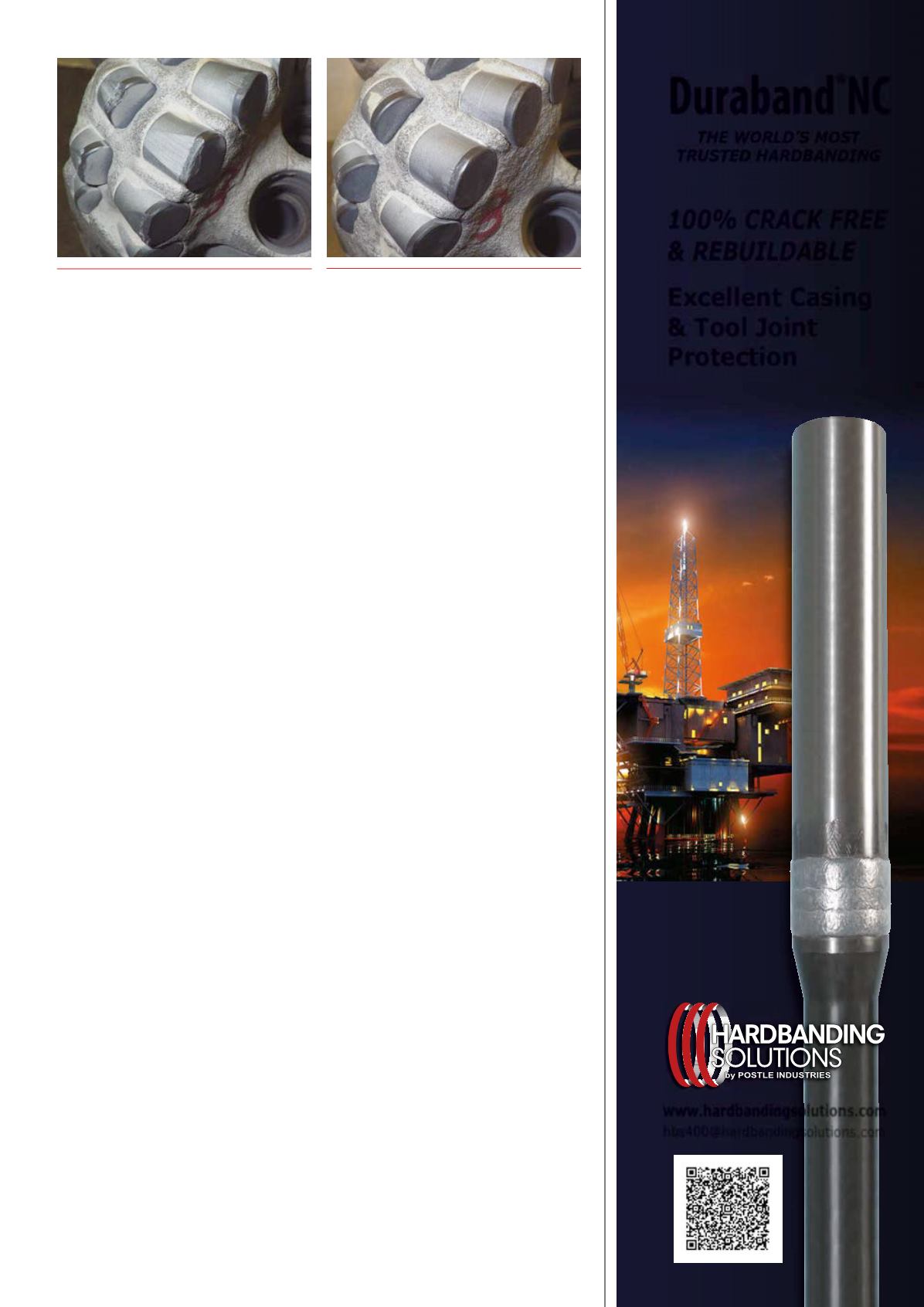
interstitial cobalt from theworking surface of thePCD through acid leaching, which
dramatically improves the thermal stability of the cutter on that surface. However,
it is the cobalt between thediamond grains that gives thePCD its toughness, and so
by removing that cobalt, the overall toughness of the cutter is dramatically reduced.
There aremany tests conducted in the industry tomeasure the toughness of
a cutter, i.e., its resistance to chipping, spalling or breakingwhiledrilling. It is,
however, generally accepted that none of the laboratory tests inpractice today are
directly indicative of the actual toughness of a cutter, as it is extremely difficult
to accurately replicate thedownhole conditions that causePDC cutters to chip,
spall or break. Sowhile these tests haveproven to suggestwhich cutters aremore
likely to resist breakage thanothers, none are an absolutemeasure of toughness.
Interestingly, in all of the tests currently conducted in the industry, every one shows
a very largedecrease in toughness due to the leachingprocess –when comparing
identical cutters in the unleached and leached condition, the toughness values for
leached cutters generally decreaseby 20 - 50%. As reportedby J.D. Belnap, fracture
toughnesswas found todecreaseby almost 30%due to the leachingprocess
(Figure 1).
1
This is theprimary reasonwhy thepredominant dull condition for
PDC cutters is nowbreakage andnotwear.
Lesscobalt,stilltough
Unlike leached cutters, HDCutters achieveenhancedwear resistancedue toa
dramaticoverall reduction in cobalt content – throughout theentirePCDas
opposed toonlyat theouter surface. Thenewhigher pressure sinteringprocess
allows stronger diamond-to-diamondbonds, while requiring less cobalt to catalyse
the sinteringprocess, thusproducingaPCDwithamuch larger percentageof
diamond thana conventional cutter. The resultingPCDhas up to50% less cobalt than
adeep-leached cutter, but also retains cobalt throughout theentirePCD tomaximise
toughness. In fact, thenew structure is sodense that it is no longer conducive to
the leachingprocess. Inorder for aPCD tobe leached, themicrostructuremust be
porous enough toallow theacid to reach the cobalt. However, HDCutters are so
denselypackedwithdiamond that theacid cannot penetrate toa significant depth.
In comparison to conventional deep leached cutters, HDCutters havemorediamond,
whichequates tobetter abrasion resistance, less cobalt throughout thePCD, which
equates tobetter overall thermal stability, and stronger diamondbonds and cobalt
throughout themicrostructure, which results inhigh toughness. Hundreds of field
tests havebeen completed todate that have conclusivelyproven theperformance
benefits realised through this new technology, anda fewof thesewill be reviewed in
this article.
Because thereare somanyadditional variables associatedwithdirectional
drilling, the case studies includedherewill focus onlyon vertical sections and
horizontal sections. Indirectional applications, thebit performance characteristics of
the run, (ROP, footagedrilledanddull condition), are typicallyovershadowedby the
directional requirements of the interval, and therefore the relativeperformanceof
agiven cutter compared toanother canbemoredifficult todetermine. Soalthough
manydramaticperformance increases havebeenachieved indirectional applications,
it isdifficult todemonstrate that improvement accurately in thedata. However, in
both vertical andhorizontal applications, thedirectional requirements are typically
less significant, whichallowsbetter focus onbit performance characteristics.
Figure4.
6
⅛
in.HorizontalSeries-SH513DE
dullbitwithSDcutters.
Figure5.
6
⅛
in.HorizontalSeries-SH513DE
dullbitwithHDCutters.
100%CRACK FREE
&REBUILDABLE
Excellent Casing
& Tool Joint
Protection
THEWoRLD’sMosT
TRUsTEDHARDBAnDIng
Duraband
®
NC


